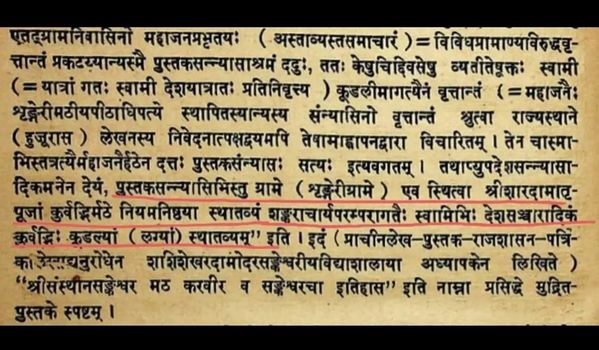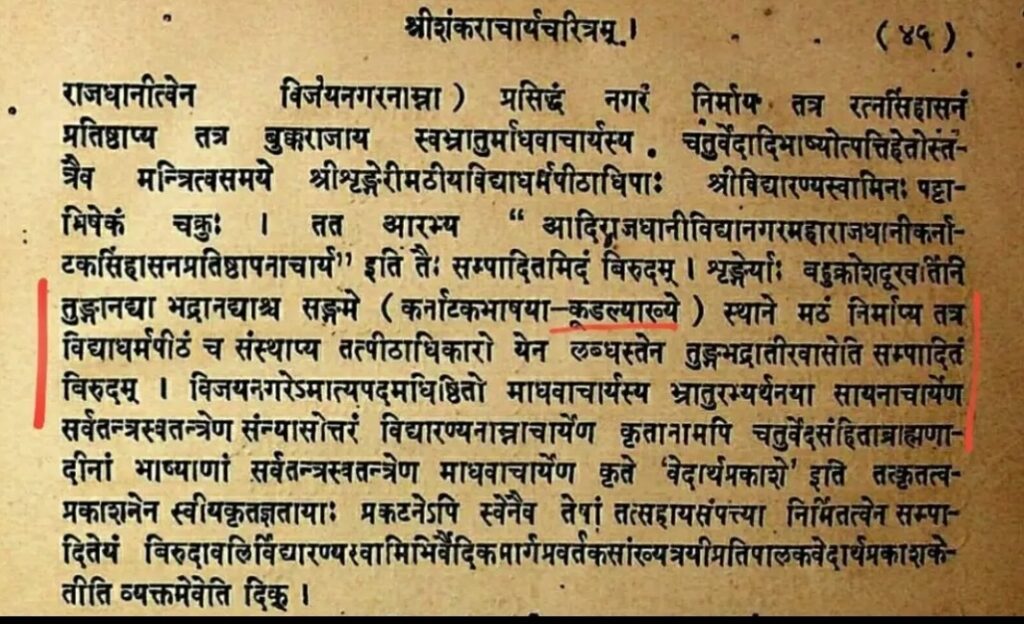Scholars who support the four mutts theory are requested to provide evidence for existence of at least one Mathamnaya manuscript written before the 18th century, as many believe this work is of recent origin.
Author: Shankarasampradayakosh
8ஆம் நூற்றாண்டில் தென் இந்தியா
கேள்வி:
8ஆம் நூற்றாண்டில் தென் இந்தியாவில் ஆழ்வார்கள், நாயன்மார்களின் வழிவந்த பக்தி இயக்கங்கள், மன்னர்கள் மற்றும் மக்கள் பங்களிப்புடன் முழுமையாக வளர்ந்திருந்ததை சரித்திரச் சான்றுகள் நமக்குக் காட்டுகின்றன. சங்கர விஜயங்களில் சொல்லப்பட்டுள்ள வரலாற்றுச் சம்பவங்கள், அவரது சமயப் பணிகள் ஆகியன.. ஒன்று கூட இந்த கால கட்டத்தில் நிகழ்ந்திருக்க வாய்ப்பில்லை. எனவே சங்கராவதாரம் பொ.யு 788ஆம் ஆண்டிலன்றி அதற்கும் பல நூற்றாண்டுகள் முன்புதானே நிகழ்ந்திருக்க வேண்டும்?
Tatanka Pratishta Claim
Did Tunga Mathadhipati perform Tatanka Pratishta in 1764 CE, or
at any time before or after?
Advent of Shankaracharya : Tunga Adherents’ uncertainty in 1958 & Advocate Krishnaswamy Iyer’s Admission
In 1958, Advocate Krishnaswamy Iyer, Tirunelveli, a staunch adherent of Tunga matha in his book published by the Srirangam Vani Vilas Press, reveals that even at that time, they lacked clarity about Shri Shankaracharya’s birth year, His establishment of four mathas, or Kedara as His place of Siddhi. Iyer justifies the absence of evidence, dismissing such debates as unproductive.This prompts the question: how, why and when were their baseless theories- 788 as His Birth year, the founding of only 4 mathas and kedara as his place of siddhi – systematically planted and propagated by the adherents of Tunga Matha when they themselves were not aware of thse details even in 1958?
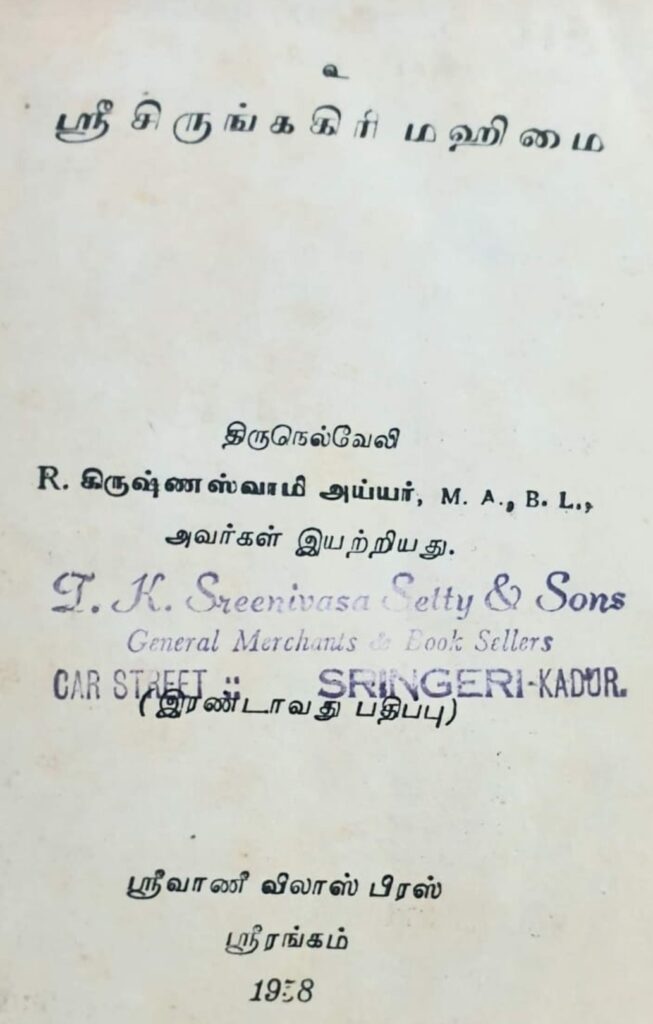
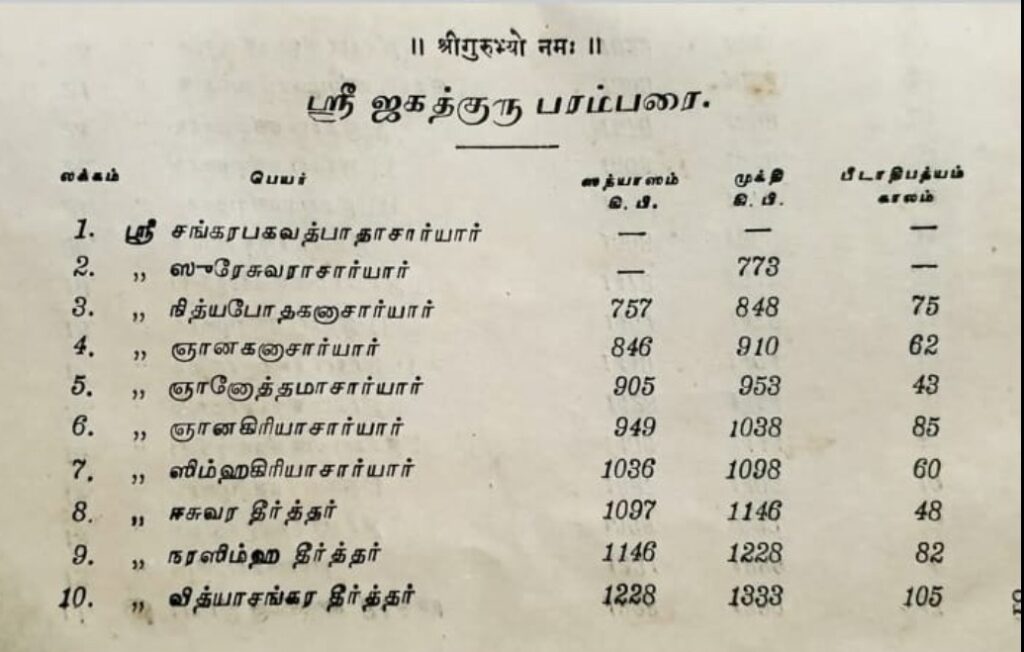
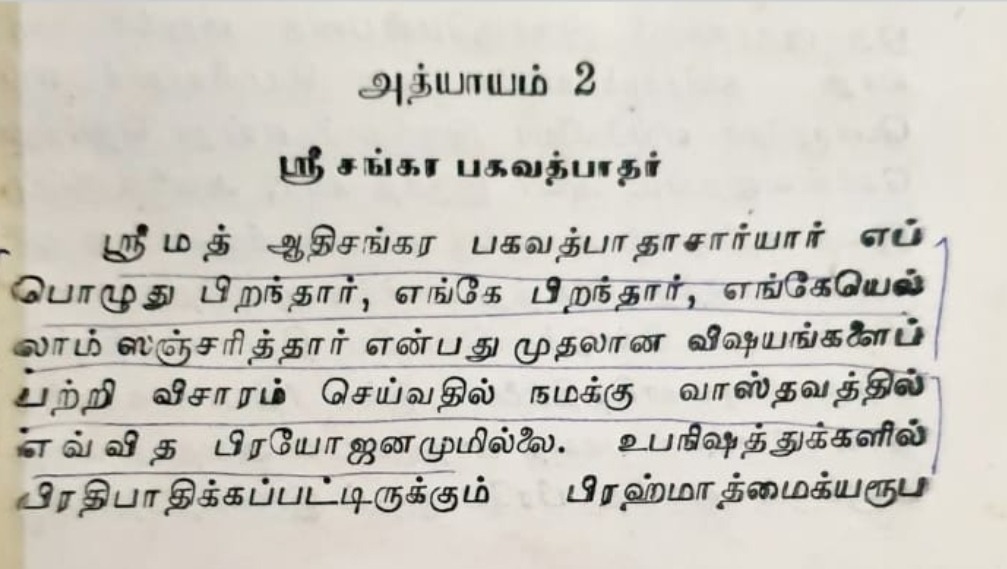
Why is Sringeri So called?
“Why is Sringeri So called?”In Karnataka, many sacred places bear the suffix Sringeri with their name. This name has its origin from Sage Rishyasringa, who performed tapas in the Kudali Kshetra, situated at the confluence of the Tunga and Bhadra rivers. Ancient Inscriptions of Karnataka, studied by B.L.Rice and others, reveal that the sacred hill emerged at this spot due to his intense penance was revered as “Sringa-Giri” in his honor. Over time, the place became known as “Kudali Sringeri”.Source: Epigraphia Carnatica, Vol VI, Inscriptions of Kadur District By B.Lewis Rice, Mysore Government Central Press, Bangalore (1901).
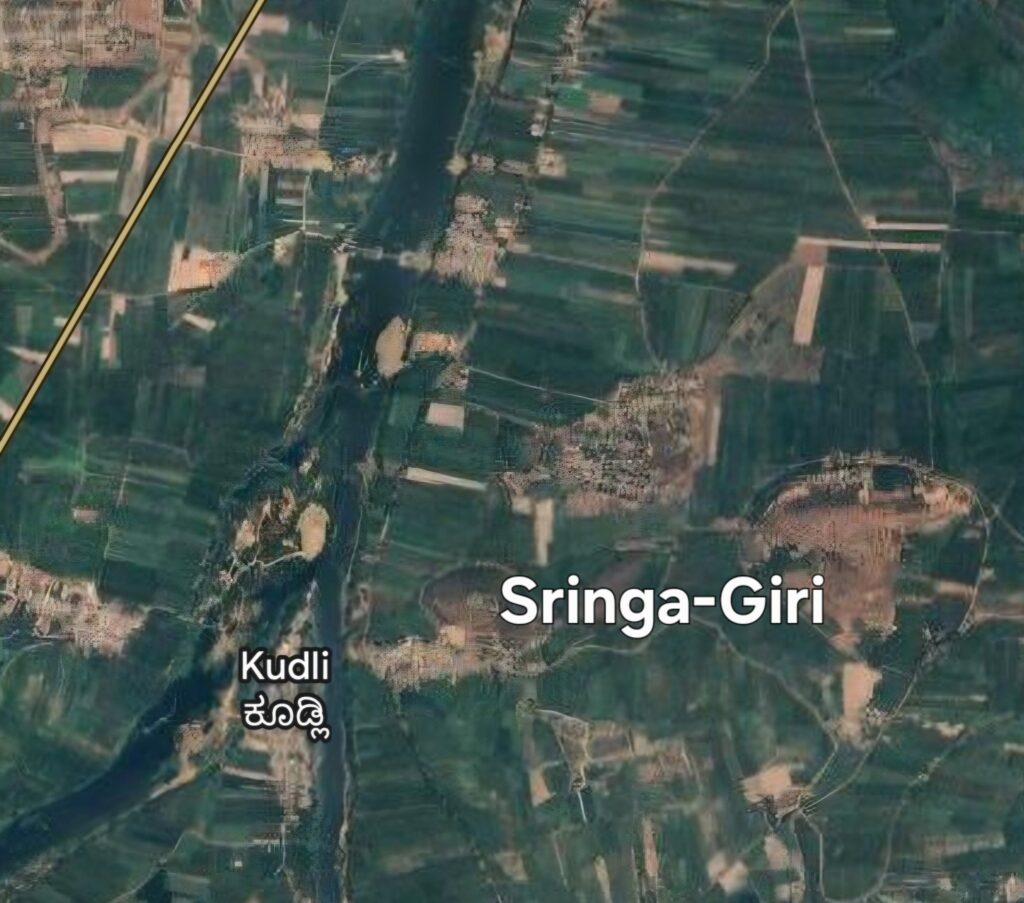
King Sahu’s Intervention to Resolve Spiritual Jurisdiction Disputes Among Kudali, Shankeshvara, and Tunga Mathas (1725 C.E.)
In 1725 C.E., during the reign of King Sahu in the Maratha country, the Swamis of Kudali, Shankeshvara, and Tunga Mathas visited Satara at the king’s invitation in order to resolve their dispute regarding their spiritual jurisdictions amicably. In this important meeting, with the unanimous consent of the Acharyas of Kudali, Shankeshvara, and Tunga Mathas, King Sahu allocated the territories: the northern regions were assigned to Shankeshvara Matha, the southern regions to Kudali Matha, and the Tunga Matha was entrusted with the worship of Shri Sharadamba at their location. Notably, there was no mention of modern texts like the Mathamnaya or Madhaviya during their discussion. This confirms that such ideas were promoted only at a later time.(Sources: History of Sankesvara Mutt, Article published in Indian Patriot, April -June 1912 & Sringeri Matt (Its History) published by (Aviccinna?) Kudali mutt)
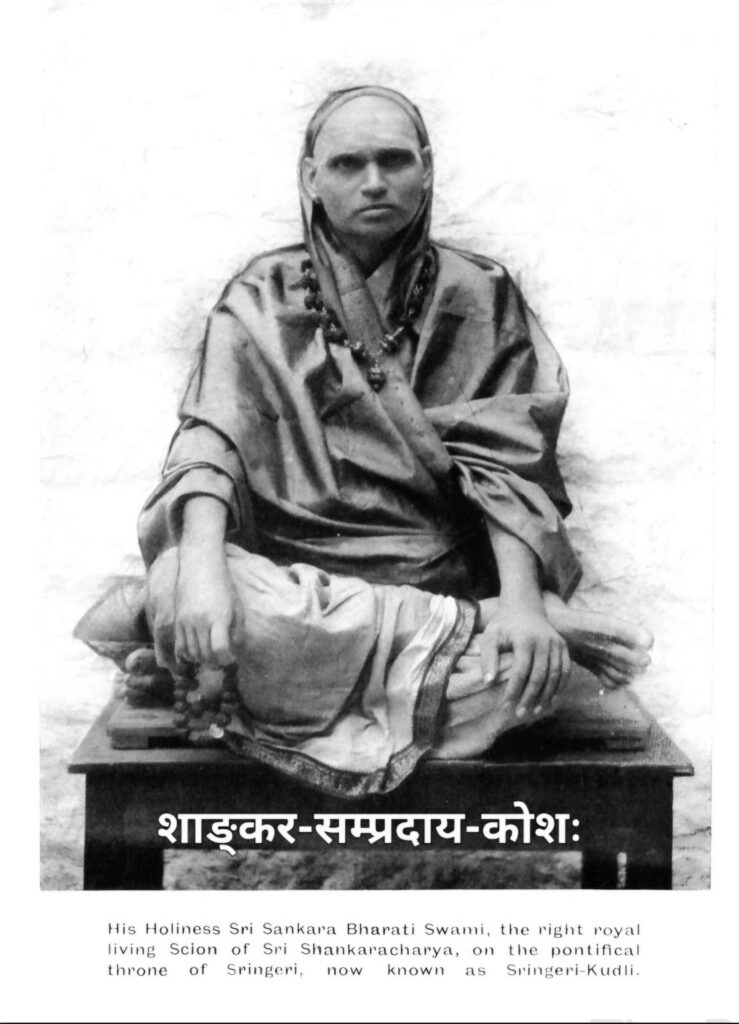
Save Mathas from Takeover
Historical records show that the Kudali Sringeri, Shivaganga, Avani and Hariharapura mathas are independent religious institutions and not branches of any other matha. The unique traditions, religious practices and denominational autonomy of the ancient advaitic religious institutions of Southern India should not be overridden by the mere nomination of a successor or otherwise by another matha. Those who attempt to usurp or interfere with their autonomy by any of these modes should know that corporate-style mergers, acquisitions and takeover have no place here.
அத்வைதமே வைதிக தர்ஶனம்”
அத்வைதமே வேதத்தில் கூறப்பட்டுள்ள ஶாஸ்த்ரம் ஆகும் என்பதற்குச் சான்றுகள் அனேகம் உள. ஸ்ரீமஹாபாரதம் ஶாந்தி பர்வத்தில் “सांख्यं योगः पाञ्चरात्रं वेदाः पाशुपतं तथा” என்று கூறப்பட்டுள்ளமை ஈண்டு அறியற்பாலது. இங்கு ஸாங்க்யம், யோகம், பாஞ்சராத்ரம், பாஶுபதம் என்னும் நான்கினும் வேறான ஒன்றாகத் தனியே “வேதமதம்” சொல்லப்பட்டிருக்கிறது. இந்த வைதிக தர்ஶனம்தான் அத்வைத தர்ஶனம் என்பது அறிஞர் கொள்கை ஆகும்
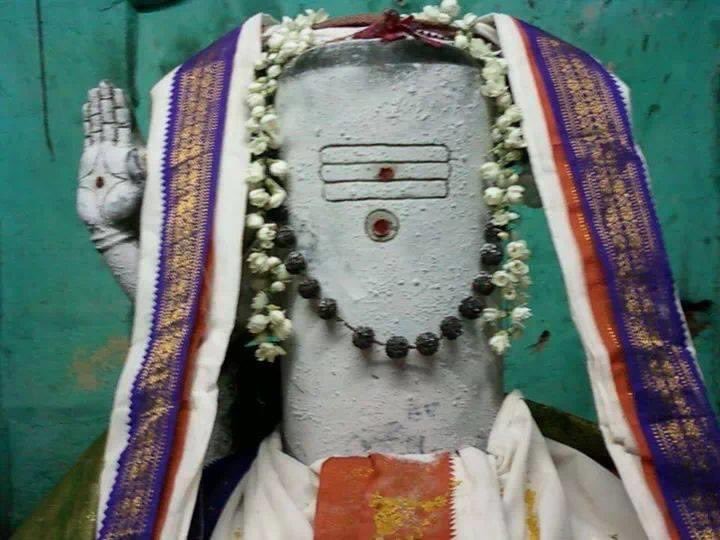
Challenging Hierarchical Dominance Claims
Many ancient maṭhas were established as independent entities with their own traditions, purposes, and spiritual lineages. Recent claims of the Tunga maṭha, referring to Kudali, Shivaganga and Amani and other maṭhas as their “branches” (śākhā maṭhas) lack any historical or scriptural basis (pramāṇa).These baseless claims, often linked to an attempt to centralize authority, are rooted in religious expansionist ideologies. They also undermine the independence and diversity of these ancient maṭhas, which have traditionally functioned as autonomous religious institutions.Courts have consistently dismissed such assertions, citing insufficient evidence and affirming the independence of maṭhas. Further, imposing hierarchical dominance through false claims violates Articles 25 and 26 of the Indian Constitution, which protect Religious Freedom and the Right of these Independant Religious Denominations to govern themselves.
FAQs: Why Tunga matha should not claim supremacy?
Q: Why Tunga Mutt In Karnataka Should Not Claim Supremacy Over Other Shankarite Institutions?
A: There had been several historical disputes where the Tunga Math in Karnataka, a monastic institution associated with the Advaita Vedanta tradition and Shri Vidyaranya Swami, sought to assert its supremacy over Moolamnaya Kanchi Math, Dakshinamnnaya Kudali Math and other Shankarite institutions.
1. Tunga Math vs. Kudali Math: In the 19th century, Tunga Math claimed Kudali Math as its branch and sought legal restrictions on the Dakshinamnaya Kudali Math’s rights. However, courts consistently ruled Kudali Math as independent Shankarite institution, allowing it to retain its distinct honors.
2. Tunga Math vs. Kanchi Math: Tunga Math tried asserting privileges over the Kanchi Kamakoti Math, established by Shri Shankara Bhavatpada, including rights to repair the Shrichakra Tatankas in the Jambukeshwaram Temple etc. The courts repeatedly dismissed Tunga math’s claims, upholding Moolamnaya Kanchi Math’s traditional rights, independent status and supremacy over Tunga Math.
3. Tunga Math vs. Shivaganga Math: Both institutions approached the Mysore Maharaja in 1831 to resolve disputes over privileges. It was finally decided that Shivaganga Math held equal rights, effectively denying Tunga’s claim to superiority.
4. Tunga Math vs. Virupaksha Math: During the 19th centiry, the Tunga Math attempted to curb the activities of Virupakasha Math.The Nizam’s High Court dismissed Tunga Math”s claims, affirming Virupaksha Math’s traditional rights to function as independent Shankarite institution.
In all these instances, Tunga Math’s attempts to claim dominance were legally challenged and defeated by the Kanchi, Kudali and other maths whose ancient records proved their independence and distinct privileges throughout history.
